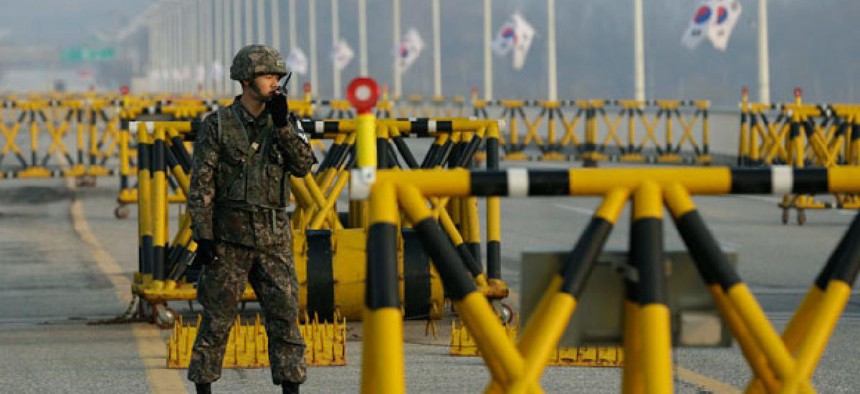S. Korea Plans Navigation System to Defeat the North's GPS Jamming

A South Korean soldier uses his radio at Unification Bridge. Lee Jin-man/AP
The technology was abandoned by the U.S. in 2010.
Faced with relentless jamming of GPS signals by North Korea, South Korea has decided to install a type of land-based radio navigation system abandoned by the United States in 2010.
The country’s plan to deploy an enhanced Long Range Navigation System, known as eLoran, as a complement to GPS, was revealed in a paper presented at the European Navigation Conference in Vienna in April by Jiwon Seo, an assistant professor in the school of integrated technology at South Korea’s Yonsei University and Mincheol Kim, a deputy director of the maritime safety facilities division in the Ministry of Oceans and Fisheries. The news was first reported by InsideGNSS.
North Korea repeatedly jammed GPS signals in South Korea from 2010 through 2012, and the durations of the jamming increased from four in days in 2010 to 16 days in 2012, the paper said. In 2012, the jamming knocked out GPS receivers on 1,016 airplanes and 254 ships, they reported, while in 2010 and 2011 the jamming hit ships, aircraft and 181 and 145 cell phone towers, respectively, the authors said.
“Considering the continuous threats from North Korea and the critical infrastructures of South Korea relying on GPS, the South Korean government has recently decided to deploy a high-power terrestrial radio navigation system, eLoran, as a complementary navigation and timing system,” Seo and Kim wrote in an updated version of their paper posted on May 10.
Loran was developed in World War II and was overtaken by GPS as a preferred radio navigation system during the past decade. South Korea operates two Loran stations and will upgrade them to broadcast eLoran signals and build another three stations to blanket the country with signals, which have a position accuracy within 65 feet, Seo and Kim said, compared to 25 feet for GPS.
South Korea, like the United States, also operates a national differential GPS system, which improves the accuracy of GPS signals from feet to inches and broadcasts those signals over terrestrial low frequency transmitters. Seo and Kim said South Korea will use 43 differential GPS stations to also broadcast the eLoran signal.
South Korea plans to have its eLoran system installed by 2018, following tests in 2016 and 2017.
The U.S. abandoned Loran due to the manning costs incurred by the Coast Guard, which literally blew-up the tower of the Port Clarence, Alaska station in 2010.
The Department of Transportation’s John A. Volpe National Transportation Systems Center warned of dangers to GPS and the national infrastructure in an Aug, 2001 report and called for development of a backup system, with Loran a potential candidate. The U.S. still has not developed a GPS back up system.






